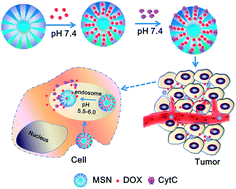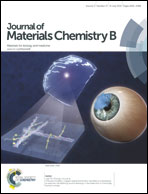Cytochrome C capped mesoporous silica nanocarriers for pH-sensitive and sustained drug release†
Abstract
In this paper, pH-responsive drug nanocarriers based on mesoporous silica nanoparticles (MSNs) capped with a natural, nontoxic protein cytochrome C (CytC) are designed and demonstrated for cancer therapy. At neutral pH the positively charged CytC can prevent the premature release of a preloaded anti-cancer drug. The results show that the CytC capped nanocarriers have excellent doxorubicin (DOX) loading efficiency (414 μg mg−1 MSN) and the leakage of the drug is only 16% at pH 7.4 phosphate-buffered saline for 72 h. Simultaneously, the DOX release percentage can reach 54% by decreasing the pH to 5.5. In contrast, unsealed MSNs show a fast DOX release rate at pH 7.4 and a slight pH-response. Confocal laser scanning microscopy demonstrates that the nanocarriers can enter human breast cancer MCF-7 cells and the DOX is sustained released from the drug carriers. Cytotoxicity tests and histological assays confirm that the constructed CytC capped nanocarriers possess lower toxicity than free DOX and unsealed drug carriers. Furthermore, intratumoral administration of the nanocarriers is significantly more efficacious in tumor reduction than free DOX and unsealed drug carriers in the xenograft models of MCF-7 cancer. Overall, this study demonstrates new drug nanocarriers with pH-sensitive and sustained drug release properties by using natural and nontoxic proteins as pore blockers to achieve highly efficient cancer treatment.


 Please wait while we load your content...
Please wait while we load your content...